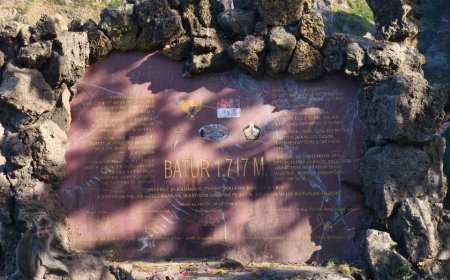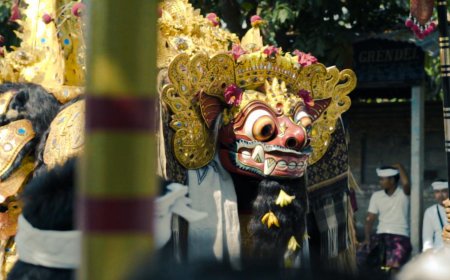The Sacred Baris Balawadwa Dance: A Legacy of Ancestral Bravery from Pupuan Village
The Baris Balawadwa Dance is a symbolic homage to the ancestors, a sacred dance with profound historical and spiritual significance in Pupuan Village, Tabanan, Bali. Uniquely, the number of dancers is limited to only 6-12 men. This dance is not merely for entertainment; it can only be performed on specific occasions as determined by tradition, such as during the piodalan ceremonies at Pura Duur Kauh Kayu Padi and Pura Puseh Desa Bale Agung.

Bali Island is one of the islands known for its vast natural beauty and diverse culture. When exploring Bali, one is sure to be captivated and amazed by the local wisdom that can be found throughout the island. One of the cultural treasures that can be encountered is the Baris Balawadwa Dance. This traditional war dance is performed exclusively by men to depict the spirit of unity and loyalty of warriors who are ready to fight to protect the village and ensure the continuity of religious ceremonies. The dance movements are filled with firmness and strength, reflecting the bravery of Balinese warriors who are willing to sacrifice for the safety and honor of their village. The Baris Balawadwa Dance is not merely a form of entertainment, it carries deep spiritual significance, serving as a sacred ritual that connects the community with their ancestors.
Performance of Baris Balawadwa Dance at Pura Pusah Desa Bale Agung (Source: Personal Collection)
The movements displayed in this dance symbolize the courage and readiness of the warriors to face threats, with tempo variations from slow to fast, reflecting the dynamics of a battlefield. This dance is also unique due to the costumes worn by the dancers. They wear traditional clothing with a camouflage pattern, symbolizing firmness and bravery. Additionally, each dancer carries a spear as part of the equipment, reflecting their readiness for battle. These costumes aim to convey the impression that the dancers are portraying a war unit ready to protect the village from enemy attacks.
Furthermore, the accompanying music, or "tabuh," in this dance has a special composition, played only during religious ceremonies. The gamelan used has a dynamic rhythm that follows the dancers' movements, which vary from slow and contemplative to fast, reflecting the spirit of battle. The music creates a solemn yet mystical atmosphere, adding to the sacred impression of the dance.
Performance of Baris Balawadwa Dance at Pura Duur Kauh Kayu Padi (Source: Personal Collection)
Baris Balawadwa is a sacred offering performed with great reverence by the people of Pupuan Village, Tabanan, Bali. The name "Baris Balawadwa" comes from the words "Bala," meaning soldiers, and "Wadwa," meaning unity and solidarity. As the name suggests, this dance symbolizes the spirit of unity and loyalty of warriors ready to sacrifice to protect the village and ensure the continuity of religious ceremonies. In a spiritual context, the Baris Balawadwa Dance is also considered a representation of protective forces that maintain the balance between the supernatural and the physical worlds.
However, behind the uniqueness and sanctity of this dance lies a historical story with deep meaning for the local community. The history of the Baris Balawadwa Dance is closely related to the arrival of Sri Bima Sakti, a leader from Java, to the remote village of Pupuan. The locals believe in a story passed down through generations that Sri Bima Sakti and his entourage arrived in the western part of Pupuan Village, which was still a forest at that time. Upon arrival, they built a simple place of worship called "bebaturan." Bebaturan itself is a temple without a shrine, consisting only of a stone altar. In the tradition of the Pupuan indigenous community, this bebaturan stands as a witness to the presence of Sri Bima Sakti and his followers and has become a sacred symbol of worship.
Pura Duur Kauh Kayu Padi (Source: Personal Collection)
To commemorate the arrival of Sri Bima Sakti and his entourage, the people of Pupuan Village eventually established a religious ceremony known as Piodalan. The community celebrates Piodalan annually, a day after the full moon of Kapat, as part of the festivities at Pura Duur Kauh Kayu Padi, one of the most revered temples in Pupuan Village. Pura Duur Kauh Kayu Padi holds great historical and sacred value, as it is believed to be the place where Sri Bima Sakti first set foot upon arriving in the village. The community believes that this temple is a place of blessing, where the spiritual power of Sri Bima Sakti can be felt and spreads throughout the village, maintaining harmony and well-being. Therefore, each Piodalan at Pura Duur Kauh Kayu Padi is not only a moment for prayer but also for strengthening the bonds of togetherness and brotherhood among the villagers. During this time, the community also performs the Baris Balawadwa Dance as a tribute to the loyal guardians of Sri Bima Sakti who faithfully protected the village.
Baris Balawadwa Dance at Pura Pusah Desa Bale Agung (Source: Personal Collection)
The traditional community of Pupuan holds a strong belief in the spiritual significance of the Baris Balawadwa Dance. For them, this dance is not merely a form of traditional artistic expression, but also a medium of communication with the ancestors and the gods believed to protect and maintain the harmony of the village. Each movement performed by the dancers carries prayers, hopes, and reverence for the sacred forces that are believed to be present, providing protection and well-being.
Therefore, the performance of the Baris Balawadwa Dance cannot be done arbitrarily. It is only presented on specific occasions as determined by local customs, usually during religious ceremonies or important celebrations. One of the key occasions for the performance of this dance is during the Piodalan, the temple anniversary celebration, at Pura Duur Kauh Kayu Padi and Pura Puseh Desa Bale Agung. It is during this time that the community gathers to witness and feel the sacred atmosphere of the dance, as if merging with the spiritual energy emanating from each movement and the accompanying musical rhythms.
Pura Puseh Desa Bale Agung (Source: Personal Collection)
The Baris Balawadwa Dance is a cultural heritage rich in historical and spiritual values. As a sacred dance, it not only conveys a story of unity and bravery but also serves as a means to maintain spiritual balance between the physical world and the spiritual realm. The traditional community of Pupuan, with their strong commitment, continues to preserve this tradition as an essential part of their lives. The preservation of the Baris Balawadwa Dance is not only about sustaining ancestral heritage but also about safeguarding the cultural identity that defines the people of Pupuan.
































































